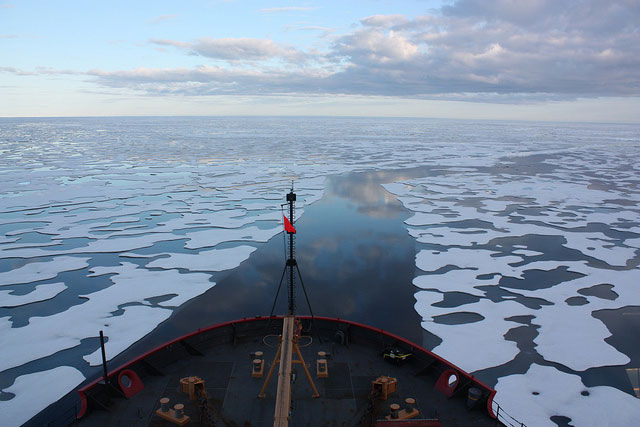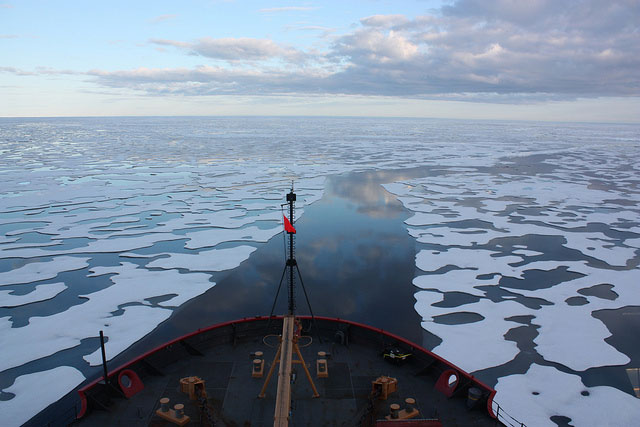
Part of the Series
Planet or Profit
Support justice-driven, accurate and transparent news — make a quick donation to Truthout today!
 Scientists on board the US Coast Guard Cutter Healy in the Beaufort Sea, northeast of Barrow, Alaska, finished collecting the mission’s sea ice data and cruised south on July 20, 2011, through thin ice and ultimately into the open ocean. Corporations are now capitalizing on the melting of the ice by sending luxury cruise ships into the newly opened passageways. (Photo: NASA Goddard Space Flight Center)
Scientists on board the US Coast Guard Cutter Healy in the Beaufort Sea, northeast of Barrow, Alaska, finished collecting the mission’s sea ice data and cruised south on July 20, 2011, through thin ice and ultimately into the open ocean. Corporations are now capitalizing on the melting of the ice by sending luxury cruise ships into the newly opened passageways. (Photo: NASA Goddard Space Flight Center)
Until this summer, Arctic sea ice prevented luxury cruise ships from using the famed Northwest Passage. The sea route, which connects the northern Pacific and the Northern Atlantic via the Arctic Ocean across the north coast of the North American Continent, was known for centuries to explorers seeking a possible trade route.
The Arctic ice pack, however, prevented any use of the route for trade or other purposes until 2009, when marine shipping began to be possible due to the rapid melting of Arctic sea ice. This melting has been one of the most dramatic and obvious impacts of runaway anthropogenic climate disruption (ACD).
To see more stories like this, visit “Planet or Profit?”
Many sea ice experts predict summer periods of an ice-free Arctic by the year 2050, with some even predicting it will happen within the next year or two. Whenever it happens, it will be the first time in over 10,000 years that the Arctic sea ice will have disappeared.
Corporations haven’t missed a beat in taking advantage of the newly opened passageway. One company, Los Angeles-based Crystal Cruises, is already operating a luxury cruise there and is taking bookings now for a second one next year.
Watching Ecosystem Collapse in Luxury
As Truthout reported on September 12, the 820-foot long Crystal Serenity cruise ship set sail in late August from Seward, Alaska en route to New York, via the Arctic.
The ship has 13 decks, 535 staterooms, multiple swimming pools, a golf driving range, putting green, casino, spa, fitness center, hair salon, movie theater, and of course, 24-hour room service.
Carrying upwards of 1,700 passengers and crew, cruise prices started at $22,000 per person. For those willing to fork over more, helicopter rides and excursions onto the melting Greenland Ice Sheet were available for an additional fee.
Now, the same company is already selling rooms for next summer’s cruise.
According to Crystal Cruises’ website, the 32-day cruise next year will run from August 15 to September 16, and promises “unprecedented adventures” and “unsurpassed luxury.”
“Follow in the footsteps of intrepid explorers as you sail through unparalleled landscapes of grand glaciers, stunning fjords, and rare wildlife sightings as you learn the Arctic culture and its fascinating people,” it adds.
The least expensive room (and all these prices are per person, based on double occupancy) is $21,855. The top of the price range is for a room in the Crystal Penthouse, which includes its own private verandah, for a cool $120,095 per person. This room is over 1,000 square feet and has its own living room, dining area and personal butler service.
Assuming that those willing and able to pay over $120,000 for a one-month cruise will grow bored with looking out their window at the Arctic, the bedroom, living room and bathroom all have their own flat-screen TVs and DVD players.
The master bathroom has its own Jacuzzi and of course, the penthouse has a walk-in closet.
An Accident Waiting to Happen
Accidents happen all the time with cruise ships, but rarely make it into the media outside of the local areas where they occur.
Just two months before the Crystal Serenity set sail for the Arctic, another cruise ship, the Celebrity Infinity, crashed into a dock in Ketchikan, Alaska.
The crash was not unusual. Incidents of mechanical malfunctions and injuries to cruise-ship passengers are common — as are more serious disasters. According to Cruise Minus, 55 cruise ships sank in the period from 1979 to 2013, with 15 of those occurring since 2000. In that same time frame, there were 106 cruise ship collisions, with 79 of those occurring between 2005 and 2013.
Fires aboard cruise ships are also quite common, as there have been 139 cruise ship fires reported between 1990 and 2013, with 101 of them happening between 2005 and 2013: an average of more than one dozen per year for this most recent period alone.
Crystal Cruises is not without its own issues.
In 2009, the Crystal Serenity ship was fined for illegal dumping of pollution in Croatia. Just after leaving port in Dubrovnik, the port’s harbormaster caught the ship in the illegal act and it was fined nearly 10,000 euros for the incident.
In 2003, another Crystal Cruises ship was banned from the harbor in Monterey, California, after dumping thousands of gallons of its waste water into the Monterey Bay National Marine Sanctuary.
These practices will be all the more damaging in the fragile Arctic ecocystem. In addition to the obvious impacts of dumping sewage or other waste into that environment, engine noise from the ship will also impact marine life there that, until recently, has not had to deal with anything like it.
Moreover, when major cruise ship accidents happen, oil spills occur. For example, a cruise ship sank in Antarctica in 2007 and released a mile-long oil slick that impacted the breeding grounds of Antarctic and Adelie penguins, as well as the largest mating colony of Gentoo penguins.
That ship, the Explorer, hit an iceberg. When it did so, it had 50,000 gallons of diesel, 6,300 gallons of lubricant and 260 gallons of gasoline aboard. It sank six hours later.
The record shows that the question is not “if” a cruise ship incident — or even major accident — will occur in the Arctic, but “when.”
And when it does, the ability for rescue and emergency clean-up operations will be, to put it mildly, extremely limited.
Press freedom is under attack
As Trump cracks down on political speech, independent media is increasingly necessary.
Truthout produces reporting you won’t see in the mainstream: journalism from the frontlines of global conflict, interviews with grassroots movement leaders, high-quality legal analysis and more.
Our work is possible thanks to reader support. Help Truthout catalyze change and social justice — make a tax-deductible monthly or one-time donation today.